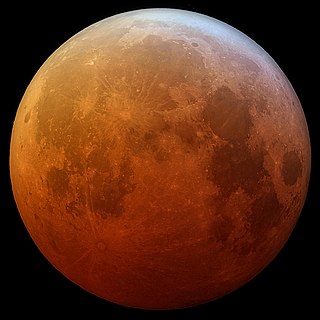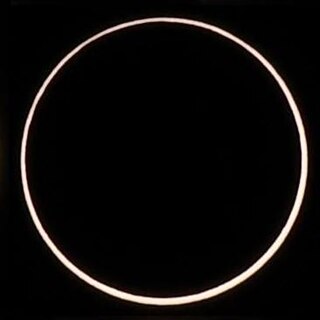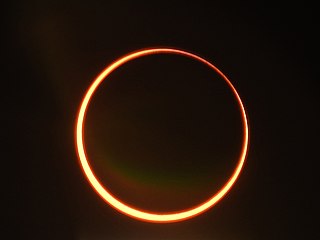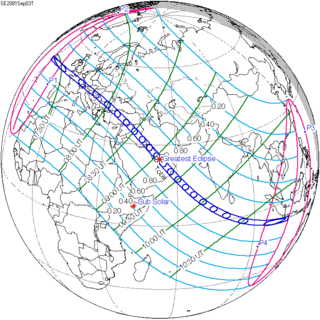
A total lunar eclipse occurred from 5:27 to 11:06 UTC on 21 December 2010, coinciding with the date of the Winter solstice in the Northern Hemisphere and Summer solstice in the Southern Hemisphere. It was visible in its entirety as a total lunar eclipse in North and South America, Iceland, Ireland, Britain and northern Scandinavia.

A total lunar eclipse took place on Friday, May 16, 2003, the first of two total lunar eclipses in 2003, the other being on November 9, 2003. A shallow total eclipse saw the Moon in relative darkness for 52 minutes and 3.1 seconds. The Moon was 12.938% of its diameter into the Earth's umbral shadow, and should have been significantly darkened. The partial eclipse lasted for 3 hours, 15 minutes and 3.1 seconds in total. Occurring only 0.5 days after perigee, the Moon's apparent diameter was 6.2% larger than average. At greatest eclipse the Moon was only 357,693 km from the Earth, making it a Super Full Moon.

A total lunar eclipse took place on 15 June 2011. It was the first of two such eclipses in 2011. The second occurred on 10 December 2011. While the visual effect of a total eclipse is variable, the Moon may have been stained a deep orange or red colour at maximum eclipse.

A partial lunar eclipse occurred on 26 June 2010, the first of two lunar eclipses in 2010. At maximum eclipse, 53.68% of the Moon was covered by the Earth's shadow.

An annular solar eclipse occurred at the Moon's ascending node of the orbit on Monday, January 26, 2009. A solar eclipse occurs when the Moon passes between Earth and the Sun, thereby totally or partly obscuring the image of the Sun for a viewer on Earth. An annular solar eclipse occurs when the Moon's apparent diameter is smaller than the Sun's, blocking most of the Sun's light and causing the Sun to look like an annulus (ring). An annular eclipse appears as a partial eclipse over a region of the Earth thousands of kilometres wide. It had a magnitude of 0.9282 and was visible from a narrow corridor beginning in the south Atlantic Ocean and sweeping eastward 900 km south of Africa, slowly curving northeast through the Indian Ocean. Its first landfall was in the Cocos Islands followed by southern Sumatra and western Java. It continued somewhat more easterly across central Borneo, across the northwestern edge of Celebes, then ending just before Mindanao, Philippines. The duration of annularity at greatest eclipse lasted 7 minutes, 53.58 seconds, but at greatest duration lasted 7 minutes, 56.05 seconds.

A total lunar eclipse took place on 15 April 2014. It was the first of two total lunar eclipses in 2014, and the first in a tetrad. Subsequent eclipses in the tetrad are those of 8 October 2014, 4 April 2015, and 28 September 2015. Occurring 6.7 days after apogee, the Moon's apparent diameter was smaller.

A total lunar eclipse took place on Wednesday 8 October 2014. It is the second of two total lunar eclipses in 2014, and the second in a tetrad. Other eclipses in the tetrad are those of 15 April 2014, 4 April 2015, and 28 September 2015. Occurring only 2.1 days after perigee, the Moon's apparent diameter was larger, 1960.6 arcseconds.

A total lunar eclipse occurred on Tuesday, 8 November 2022. The southern limb of the Moon passed through the center of the Earth's shadow. It surpassed the previous eclipse as the longest total lunar eclipse visible from nearly all of North America since 17 August 1989, and until 26 June 2029. Occurring only 5.8 days before apogee, the Moon's apparent diameter was smaller. The next total lunar eclipse will take place on 14 March 2025. A lunar occultation of Uranus happened during the eclipse. It was the first total lunar eclipse on Election Day in US history. This event was referred in media coverage as a "beaver blood moon".

A total lunar eclipse occurred on 15–16 May 2022, the first of two total lunar eclipses in 2022. The event occurred near lunar perigee; as a result, this event was referred to some in media coverage as a "super flower blood moon" and elsewhere as a "super blood moon", a supermoon that coincides with a total lunar eclipse. This was the longest total lunar eclipse visible from nearly all of North America since August 17, 1989 until the next eclipse on November 8.

A total lunar eclipse occurred at the Moon's descending node on 27 July 2018. The Moon passed through the center of Earth's shadow in what was the first central lunar eclipse since 15 June 2011. It was also the second total lunar eclipse in 2018, after the one on 31 January. It was the longest total lunar eclipse of the 21st century, but not the longest in the 3rd millennium. The longest total lunar eclipse of the 3rd millennium will occur on May 12, 2264, lasting 106 minutes and 13.2 seconds, which will be the longest total lunar eclipse since 2000, and the longest one until 3107.

A total lunar eclipse occurred on 31 January 2018. The Moon was near its perigee on 30 January and as such may be described as a "supermoon", when the Moon's distance from the Earth is less than 360,000 km. The previous supermoon lunar eclipse was in September 2015.

A total lunar eclipse occurred on 21 January 2019 UTC. For observers in the Americas, the eclipse took place between the evening of Sunday, 20 January and the early morning hours of Monday, 21 January. For observers in Europe and Africa, the eclipse occurred during the morning of 21 January. The Moon was near its perigee on 21 January and as such can be described as a "supermoon".

A partial lunar eclipse occurred on the 16 and 17 July 2019. The Moon was covered 65.31% by the Earth's umbral shadow at maximum eclipse.

A partial lunar eclipse occurred on 19 November 2021. The eclipse occurred towards a micromoon. This was the longest partial lunar eclipse since 18 February 1440, and the longest until 8 February, 2669; however, many eclipses, including the November 2022 lunar eclipse, have a longer period of umbral contact at next to 3 hours 40 minutes. It was often referred to as a "Beaver Blood Moon" although not technically fulfilling the criteria for a true blood moon (totality).

A total lunar eclipse took place on Monday, April 24, 1967, the first of two total lunar eclipses in 1967, the second being on October 18, 1967.

An annular solar eclipse occurred on September 1, 2016. A solar eclipse occurs when the Moon passes between Earth and the Sun, thereby totally or partly obscuring the image of the Sun for a viewer on Earth. An annular solar eclipse occurs when the Moon's apparent diameter is smaller than the Sun's, blocking most of the Sun's light and causing the Sun to look like an annulus (ring). An annular eclipse appears as a partial eclipse over a region of the Earth thousands of kilometres wide. In this case, annularity was observed in Gabon, Congo, Democratic Republic of the Congo, Tanzania, Mozambique, Madagascar, and Reunion.

An annular solar eclipse occurred at the Moon’s descending node of the orbit on Thursday, December 26, 2019. A solar eclipse occurs when the Moon passes between Earth and the Sun, thereby totally or partly obscuring the Sun for a viewer on Earth. An annular solar eclipse occurs when the Moon's apparent diameter is smaller than the Sun's, blocking most of the Sun's light and causing the Sun to look like an annulus (ring). An annular eclipse appears as a partial eclipse over a region of the Earth thousands of kilometres wide.

A total solar eclipse will occur on Wednesday, September 3, 2081. A solar eclipse occurs when the Moon passes between Earth and the Sun, thereby totally or partly obscuring the image of the Sun for a viewer on Earth. A total solar eclipse occurs when the Moon's apparent diameter is larger than the Sun's, blocking all direct sunlight, turning day into darkness. Totality occurs in a narrow path across Earth's surface, with the partial solar eclipse visible over a surrounding region thousands of kilometres wide. The path of totality will begin at the Atlantic Ocean, off European mainland at 07:26:49 UTC and will end at Indonesian island of Java at 10:43:03 UTC.

An annular solar eclipse occurred on Sunday, June 21, 2020. An annular solar eclipse is a solar eclipse whose presentation looks like a ring, or annulus; it occurs when the Moon's apparent diameter is smaller than the Sun's, blocking most, but not all, of the Sun's light. In this instance, the Moon's apparent diameter was 0.6% smaller than the Sun's.

An annular solar eclipse occurred on Thursday, June 10, 2021, when the Moon passed between Earth and the Sun, thereby partly obscuring the image of the Sun for a viewer on Earth. During the eclipse, the Moon's apparent diameter was smaller than the Sun's, so it caused the Sun to look like an annulus. The annular eclipse was visible from parts of northeastern Canada, Greenland, the Arctic Ocean, and the Russian Far East, whilst the eclipse appeared partial from a region thousands of kilometres wide, which included northeastern North America, most of Europe, and northern Asia.




































































